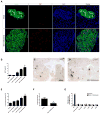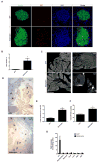Betatrophin: a hormone that controls pancreatic β cell proliferation
- PMID: 23623304
- PMCID: PMC3756510
- DOI: 10.1016/j.cell.2013.04.008
Betatrophin: a hormone that controls pancreatic β cell proliferation
Retraction in
-
Retraction Notice to: Betatrophin: A Hormone that Controls Pancreatic β Cell Proliferation.Cell. 2017 Jan 12;168(1-2):326. doi: 10.1016/j.cell.2016.12.017. Epub 2016 Dec 28. Cell. 2017. PMID: 28038792 Free PMC article. No abstract available.
Abstract
Replenishing insulin-producing pancreatic β cell mass will benefit both type I and type II diabetics. In adults, pancreatic β cells are generated primarily by self-duplication. We report on a mouse model of insulin resistance that induces dramatic pancreatic β cell proliferation and β cell mass expansion. Using this model, we identify a hormone, betatrophin, that is primarily expressed in liver and fat. Expression of betatrophin correlates with β cell proliferation in other mouse models of insulin resistance and during gestation. Transient expression of betatrophin in mouse liver significantly and specifically promotes pancreatic β cell proliferation, expands β cell mass, and improves glucose tolerance. Thus, betatrophin treatment could augment or replace insulin injections by increasing the number of endogenous insulin-producing cells in diabetics.
Copyright © 2013 Elsevier Inc. All rights reserved.
Figures






Comment in
-
Diabetes: Betatrophin--inducing β-cell expansion to treat diabetes mellitus?Nat Rev Endocrinol. 2013 Jul;9(7):379. doi: 10.1038/nrendo.2013.98. Epub 2013 May 7. Nat Rev Endocrinol. 2013. PMID: 23648871 No abstract available.
-
Metabolic disorders: Betatrophin boosts β-cells.Nat Rev Drug Discov. 2013 Jul;12(7):504. doi: 10.1038/nrd4058. Epub 2013 Jun 21. Nat Rev Drug Discov. 2013. PMID: 23787955 No abstract available.
-
Betatrophin fuels β cell proliferation: first step toward regenerative therapy?Cell Metab. 2013 Jul 2;18(1):5-6. doi: 10.1016/j.cmet.2013.06.006. Cell Metab. 2013. PMID: 23823472
-
Bulking up on beta cells.N Engl J Med. 2013 Aug 22;369(8):777-9. doi: 10.1056/NEJMcibr1307038. N Engl J Med. 2013. PMID: 23964941 No abstract available.
-
Betatrophin.Islets. 2014;6(2):e28686. doi: 10.4161/isl.28686. Islets. 2014. PMID: 25483956 Free PMC article.
References
-
- Bernard C, Thibault C, Berthault MF, Magnan C, Saulnier C, Portha B, Pralong WF, Penicaud L, Ktorza A. Pancreatic beta-cell regeneration after 48-h glucose infusion in mildly diabetic rats is not correlated with functional improvement. Diabetes. 1998;47:1058–1065. - PubMed
-
- Bock T, Pakkenberg B, Buschard K. Increased islet volume but unchanged islet number in ob/ob mice. Diabetes. 2003;52:1716–1722. - PubMed
-
- Bonner-Weir S, Deery D, Leahy JL, Weir GC. Compensatory growth of pancreatic beta-cells in adult rats after short-term glucose infusion. Diabetes. 1989;38:49–53. - PubMed
-
- Bruning JC, Winnay J, Bonner-Weir S, Taylor SI, Accili D, Kahn CR. Development of a novel polygenic model of NIDDM in mice heterozygous for IR and IRS-1 null alleles. Cell. 1997;88:561–572. - PubMed
Publication types
MeSH terms
Substances
Associated data
- Actions
Grants and funding
LinkOut - more resources
Full Text Sources
Other Literature Sources
Medical
Molecular Biology Databases

